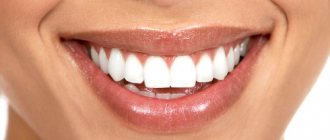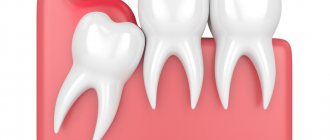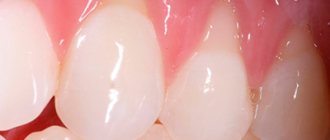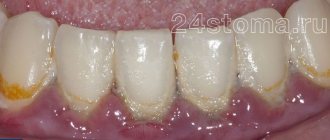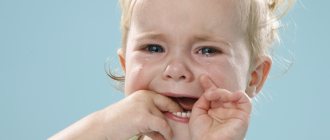Periostitis is a purulent inflammation of the periosteum, the tissue covering the bone of the upper or lower jaw. Over time, the inflammation spreads to other tissues of the oral cavity , and a painful and unpleasant abscess can grow on the gum.
Periostitis is of two types: acute and chronic . the acute one , it goes on very quickly. Inflammation is manifested by asymmetric swelling of the cheek on the side of the diseased tooth and enlargement of the lymph nodes, and an increase in temperature is observed. Chronic periostitis can pass without obvious symptoms, while negatively affecting the condition of the child’s teeth, destroying them from the inside. The chronic form often occurs due to untreated acute periodontitis, pulpitis or due to injury.
Where does the abscess come from and what is its danger?
In the vast majority of cases, an abscess on the gum is associated with a tooth, often with a milk tooth. The most amazing thing is that the tooth may appear healthy from the outside, it may have a beautiful filling, and the tooth may not hurt. Why does pus still appear?
Baby teeth are less resistant to infection than permanent teeth; they are designed for a short service life, although they, like permanent teeth, have a nerve and roots. However, the roots of baby teeth begin to dissolve after five years. Caries in such teeth spreads much faster. Within three months, a cavity can form in the tooth, reaching the nerve. If caries is not treated, all pathogenic bacteria enter the dental nerve, and then, through the nerve, the microbes enter the bone. Bone is quite comfortable for microbes. They multiply there, dissolve the bone, which is accompanied by the formation of pus. If the tooth is open, there is a hole in it, pus comes out into the oral cavity. If food particles, fragments of destroyed enamel get into the tooth, or the tooth is covered with a filling without adequate treatment, pus can no longer flow freely. If the pus cannot flow out through the tooth cavity, it begins to look for another way out. The pus melts the bone and comes out under the gum. The outer covering of the gum, under which the pus has come out, swells and takes the form of a lump. Over time, the lump may burst and pus leaks out.
Once the pus is released, the lump may disappear and the gums may heal until the pus collects in large quantities again. The danger of such “bumps” is as follows:
- there is always an infection in the body (you should never forget that the abscess is not just on the gum, but in the head);
- the pus that is in the jaw dissolves the bone and can damage the growing permanent tooth.
The disappearance of an abscess next to a tooth never means recovery.
Symptoms that appear along with an abscess
- redness on the gum;
- tooth pain (optional);
- There is a hole in the tooth or there may be a filling on it;
- enlarged lymph nodes (dense “balls” appear under the lower jaw).
Sometimes a lump is discovered by chance, and the child may not be bothered by anything at all. The parent should periodically examine the child's mouth independently.
Why do my gums hurt when teething?
To appear on the surface, the tooth needs to pass through the jaw bone and gum tissue. Although this is a natural process, it can be painful, because the tooth “grows” through the gum and violates its integrity. The gums become sensitive during tooth eruption, and pain may occur when pressing on them. These unpleasant sensations go away as soon as the tooth moves apart the gum and looks out.
Never do
You should never heat your gum or cheek, no warm compresses or salt or other “folk remedies”! It’s better not to do anything at all before going to the doctor. After warm compresses, pus may spread not only in the jaw, but also in the cheeks, throat, and neck. Situations arise that are dangerous not only to health, but also to life.
Contraindicated
- refusal to brush teeth;
- independent opening of the abscess;
- taking medications without the consent of a doctor (except for painkillers).
Gel for teething. How to choose?
If a child becomes restless and capricious during the teething period, first of all you need to create a calm environment for him, pay him more attention, pick him up more often, hug him, and talk to him.
Pain can be relieved mechanically or with medications. You can massage the gums with a clean finger or a rubber brush, let your baby suck on a dryer or chew on a teether, especially a cooled one. There are special dental gels to relieve gum pain in babies during teething. The advantages of children's gum gels are that they quickly relieve pain.
There are many more disadvantages to using them. The main two:
- If the gel contains the anesthetics benzocaine and lidocaine, they can be dangerous to the child’s health. Such drugs provide pain relief for a short time - the medicine is washed off with saliva and swallowed. It is difficult to accurately calculate the dosage when squeezing the gel out of the tube. If you also exceed the number of applications of the medicine recommended by the instructions, you may exceed the permissible limit. An overdose of lidocaine threatens with such dire consequences as convulsions, breathing problems, heart rhythm disorders - even death.
- Herbal gels provide mild pain relief, but help relieve inflammation. Their action does not give quick results. An allergic reaction to herbal components is possible, so after the first use you need to monitor the child’s reaction.
If you still decide to use a teething gel for your baby, choose either a herbal gel or a combination drug with an anesthetic and herbs. It will help relieve acute pain and reduce inflammation. But use combination gels very carefully, only as a last resort when other methods do not work and the child is in severe pain.
It is important!
Teething is a difficult period for the baby and his parents, but it is a natural stage of growing up, which allows the transition to solid food after breast milk.
Treatment
Depending on whether a permanent or baby tooth caused a lump on the child’s gum , the doctor carries out appropriate treatment. If a permanent tooth is damaged, seek help immediately while there is a chance to save the child’s tooth. The doctor will have to remove the nerve and fill the canals. In this case, adult dental treatment is a necessity, because if high-quality treatment and appropriate treatment are not carried out, the child may lose a tooth.
Milk teeth are removed immediately - their root system has not yet had time to form, and it is impossible to properly fill the canals. In addition, if a diseased tooth is left, the molar may grow back with defects (stains, damage.
At the Family Dentistry Center, you can remove a child’s tooth without pain or fear. All procedures in the clinic are performed under medical sedation. While the baby is sleeping peacefully and does not feel pain or discomfort, the doctor can carry out all the necessary procedures. Being able to treat your teeth while you sleep is a great way to cope with dental phobia.
Causes of periostitis:
• of thorough oral care Small children do not yet know how to properly take care of their teeth, so plaque and food debris accumulate in the gum pockets, which can cause inflammation;
• injury to the gums . Children, especially toddlers, love to put almost everything in their mouths. Foreign objects can not only injure the gums, but also introduce harmful microbes into the wounds;
• to caries and its complications . Baby teeth are more vulnerable, so any defect can cause infection;
• angina , tonsillitis . _
Prevention
There are no special unique ways to prevent dental disease in children. Ulcers on the gums are the result of untreated caries. Therefore, all preventive measures are aimed at preventing caries:
- oral hygiene (make sure your baby brushes his teeth properly);
- balanced diet;
- rinsing your mouth every meal;
- preventive procedures (remineralization, fluoridation; fissure sealing);
- timely dental treatment;
- preventive examinations at the dentist 2 times a year (some experts recommend once every 3 months if the baby already has treated teeth).
Timely dental treatment for children and proper hygiene will help avoid many dental problems. Teach your child to take care of the health of their teeth and beautiful children's smiles will delight you every day!
When to see a doctor
When a child is teething, his immune system is weakened. Symptoms that parents attribute to teething may be hiding a viral or bacterial infection. Don't wait for it to go away on its own and see a doctor if:
- the child has a temperature above 38.5℃;
- he became lethargic and drowsy;
- refuses food;
- Vomiting and diarrhea began.
So:
- When teeth are being cut, the baby’s gums may be painful and swollen; this is a normal phenomenon; otherwise the tooth cannot pass through the tissues of the jaw and gums;
- When the gums erupt, they look swollen, reddened, then they turn white, and a hole forms in the place of the future tooth;
- You should not use a gel to relieve pain in your baby’s gums unless absolutely necessary; if the pain bothers the child greatly, then choose gels without anesthetics or combination drugs;
- If, against the background of teething, the child has a high fever, he is very restless or, on the contrary, lethargic, refuses to eat, if vomiting or diarrhea begins, consult a doctor.
(0 ratings; article rating 0)
Share Share Share
What you need to know about gum disease in children
Healthy gums of a child are very vulnerable and delicate pale pink tissues that are easily subject to all kinds of injuries, which is not so typical for the tissues of the oral cavity of an adult. Fortunately, they are capable of rapid regeneration. It is also interesting that children’s gums can reflect the general condition of the body, acting as a litmus test for systemic diseases.
Among the most common diseases around dental tissues and gums
- Gingivitis
This inflammation occurs in 80% of children. The development of the disease in infants is facilitated by the adverse effects of general and local factors. - Gum atrophy
Up to 50% of the child population faces this serious problem. - Stomatitis
Various types of this disease are diagnosed most often in infants and preschool children. - Periodontitis
In this disease, inflammation develops in the periodontal tissues. About 5% of young dental patients are diagnosed with this condition. - Periodontal disease
Similar degenerative changes that affect periodontal tissues practically do not occur in childhood.
Gum diseases that most often occur in children
Inflammatory diseases
Gingivitis is an inflammation of the gums that occurs due to general or local exposure. Over time, untreated gingivitis can develop into periodontitis, that is, a condition where inflammation affects the periodontal tissues (bone tissue and muscle ligaments that hold the tooth in the jaw). In children, this disease is extremely rare, but still, preventive measures should not be neglected. If the development of a serious disease is not noticed in time, this can lead to loosening and further loss of the tooth. If gingivitis in a child responds well to treatment, and you can get rid of it without health consequences, then periodontitis, as a rule, becomes chronic, which is practically incurable.
The inflammatory process that accompanies the granulating form of periodontitis can provoke the formation of a cyst, and even the occurrence of a fistula on the gum. However, these complications are more typical for carious disease of dental tissues. Be that as it may, if you notice that the baby’s gums have acquired a bright red color, and deep grooves have appeared between the teeth and gums, and there is an unpleasant odor coming from the child’s mouth, then most likely the inflammation has affected not only the gums, but also deeper located periodontal tissues. You need to immediately contact pediatric dentistry, where the doctor will promptly prescribe comprehensive treatment.
Dystrophic diseases
Very often, infants and preschool children experience a pathology such as gum atrophy. The development of this negative phenomenon is facilitated by:
- incorrect orthodontic treatment;
- oral injuries;
- crowded teeth;
- all kinds of malocclusions.
Atrophy of gingival tissue is usually local in nature. It usually develops in the area of the canines and front incisors. The development of the disease is accompanied by mild inflammation. The child feels virtually no pain and has no complaints. After some time, degenerative changes cause exposure of the neck of the tooth and its root, the appearance of pathological sensitivity and severe pain.
Periodontal disease is a dystrophic disease that affects all periodontal tissues. This pathology practically does not occur in children. Its development is possible only in seriously ill babies whose immune systems are suppressed. Their body is in a state of deep vitamin deficiency. This disease is characterized by atrophy of the gums and other periodontal tissues. This incurable process can lead to complete resorption of bone tissue. In most cases, teeth that have already acquired unhealthy mobility cannot be saved. Only surgical intervention aimed at removing the affected tooth can bring a certain effect.
Risk factors
Local risk factors
Gum disease in children can be caused by a number of local factors:
- Microbes
Tartar, the formation of which is promoted by poor-quality oral cleaning, can provoke various gum diseases. First, yellow plaque accumulates on the teeth, in which pathogenic bacteria feel at ease. Then, at first glance, harmless plaque turns into hard dental deposits, which subsequently cause serious pathological changes in dental tissue and gums. - Teething
The development of gingivitis can be triggered by teething, as well as their replacement with permanent ones. - Uneven load on the dental system
This entails the development of malocclusion in the child, lethargy of chewing, the habit of chewing food on one side, a short frenulum of the tongue and lips contribute to the occurrence of gingivitis. - disruptions in the functioning of the endocrine system (adolescence and associated hormonal changes);
- diseases of the cardiovascular system;
- diseases of the gastrointestinal tract;
- respiratory system diseases;
- pathologies of the immune system, autoimmune diseases;
- hypo- and vitamin deficiency.
- swelling of the gums and bleeding;
- bad breath;
- burning and itching in the gums.
General risk factors
The following systemic diseases and changes in the functioning of body systems can provoke gum disease:
Attention: first signals!
The following factors can signal the development of gum disease in children:
The occurrence of these symptoms necessitates a visit to the dentist. The sooner the child receives help from a qualified specialist, the higher the likelihood of easy relief of the disease at the initial stage and the opportunity to reverse the nascent process.
Treating gum disease at home
How to relieve gum inflammation in a child? The best decision is to contact a pediatric dentist. However, before visiting a doctor, you can use home treatment that will help relieve symptoms for a while.
At home you can use:
- a decoction of chamomile, St. John's wort or calendula (room temperature) - used as a mouth rinse;
- baking soda solution;
- brewing black tea (has tannins);
- honey and sea buckthorn oil - you can lubricate inflammation areas with them.
St. John's wort decoction against gum inflammation



